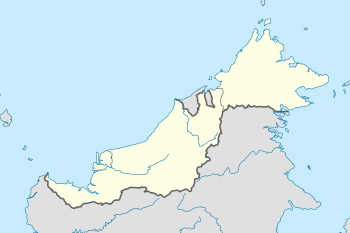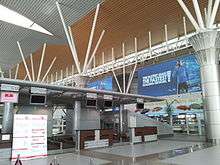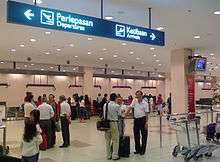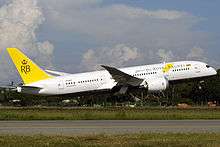Kota Kinabalu International Airport
| Kota Kinabalu International Airport Lapangan Terbang Antarabangsa Kota Kinabalu 沙巴亚庇国际机场 | |||||||||||
|---|---|---|---|---|---|---|---|---|---|---|---|
 | |||||||||||
|
IATA: BKI – ICAO: WBKK – WMO: 96471 | |||||||||||
| Summary | |||||||||||
| Airport type | Public | ||||||||||
| Owner | Government of Malaysia | ||||||||||
| Operator | Malaysia Airports Holdings Berhad | ||||||||||
| Serves | Kota Kinabalu | ||||||||||
| Location | Kepayan and Tanjung Aru, Kota Kinabalu, Sabah, Malaysia | ||||||||||
| Hub for | |||||||||||
| Time zone | MST (UTC+08:00) | ||||||||||
| Elevation AMSL | 10 ft / 3 m | ||||||||||
| Coordinates | 05°56′41″N 116°03′31″E / 5.94472°N 116.05861°ECoordinates: 05°56′41″N 116°03′31″E / 5.94472°N 116.05861°E | ||||||||||
| Map | |||||||||||
 BKI Location in East Malaysia | |||||||||||
| Runways | |||||||||||
| |||||||||||
| Statistics (2015) | |||||||||||
| |||||||||||
Kota Kinabalu International Airport (KKIA) (IATA: BKI, ICAO: WBKK) is an international airport in Kota Kinabalu, the state capital of Sabah, Malaysia. It is located approximately 8 km (5.0 mi) southwest of the city centre. In 2013, 6.9 million passengers passed through the airport, making it the second busiest airport in Malaysia after Kuala Lumpur International Airport. The airport serves the city of Kota Kinabalu as well as the entire west coast of Sabah.
History
The airport began as a military airfield built by the Imperial Japanese Army during World War II.[3] It was then known as Jesselton Airfield (Kota Kinabalu was known as Jesselton at the time). Towards the end of the war, it suffered severe bombings by Allied Forces.[4]
After the war, the Department of Civil Aviation (DCA) of North Borneo (now Sabah) took over the operation and maintenance of the airport. In 1957, the original grass strip runway was resurfaced with bitumen material and a new terminal was built.[3] By 1959, the runway had been extended to 1,593 metres to enable the operation of Malayan Airways' turboprop Viscount aircraft. In 1963, the runway was further reinforced and lengthened to 1,921 meters to cater for Comet 4 jet operations. Commercial flights and passenger arrivals gradually increased and a larger terminal building was needed. By 1967, Cathay Pacific Airways had begun operating a twice-weekly Convair 880 jet service between the airport and Hong Kong with an intermediate stop in Manila.[5]
In 1969, a British consultancy firm was appointed to formulate a Master Plan for a phased and organised development of KKIA over the next few decades. The master plan was submitted to the government with recommendations to:
- reinforce and extend the runway to 2,987 metres to cater for Boeing 707 and 747 jet operations
- build a new terminal complex and parallel taxiway connecting to the runway
- provide navigation equipment, communication facilities and a modern light system for the runway
In the 1970s and 1980s, a new terminal building was built on the other side of the runway from the original terminal. Almost all commercial flights were shifted to this newer and larger terminal. Subsequently, the original terminal became known as the Airport Lama ("Old Airport"). In 1992, the DCA of Sabah was corporatised and Malaysia Airports Holdings Berhad took over the management and operations of the airport.[3] A further expansion project for both terminals began in 2006, and in January 2007 the original terminal was rebranded Terminal 2 whilst the newer terminal became known as Terminal 1.
Terminal 2 was closed on 1 December 2015 and all airlines shifted their operations to Terminal 1.[6] There are plans to use Terminal 2 for cargo operations and general aviation.[7]
Expansion and renovation
In mid-2005, the Malaysian federal government approved major renovation and refurbishment works to the main terminal (Terminal 1) as well as a runway expansion project worth RM1.4 billion. The project saw the runway extended from 2,988 m (9,803 ft) to 3,780 m (12,402 ft) and the size of the main terminal increased from 34,000 m2 (370,000 sq ft) to 87,000 m2 (940,000 sq ft). Terminal 1 can accommodate four Boeing 747s, one Airbus A330, seven Boeing 737s, three Fokker 50s and three Dorniers at any given time. It has 12 jetways for passenger use.[8][9] The air traffic control tower, which had hitherto been attached to Terminal 1, was demolished and replaced by a stand-alone tower. Due to delays in upgrade works and disputes between the Department of Civil Aviation of Malaysia and the contractor responsible for the project, the runway extension and upgrading of the ILS (Instrument Landing System) was delayed to Q1 2014.[10]
As a result of this expansion, the airport is now able to accommodate the world's largest passenger aircraft, the Airbus A380. It has also become the second largest airport in Malaysia, with an annual capacity of 12 million passengers – 9 million for Terminal 1 and 3 million for Terminal 2.[11]
Generally, flights operating into and out of KKIA are generally serviced by narrow-body aircraft. However, during school holiday seasons, airlines such as Dragonair[12] and Malaysia Airlines[13] may upgrade their flights to wide-body aircraft such as the Airbus A330-300 and the Boeing 777-200ER. Additionally, KKIA was the first airport in Malaysia to welcome the Boeing 787 Dreamliner, operated by Royal Brunei during several product introductory flights in November 2013.[14]
Terminals


Terminal 1
Terminal 1 is the newer and the main terminal of KKIA. It can be accessed via Jalan Kepayan, Jalan Lintas and Jalan Putatan. The terminal is capable of handling 9 million passengers per annum and is equipped with the following facilities:
- 64 check-in counters for international and domestic flights
- 2 baggage x-ray check-in machines and 5 hand luggage x-ray machines (3 for departures, 1 for VIPs and 1 for staff)
- 36 immigration counters (16 for departures and 20 for arrivals)
- 6 baggage carousels
- 3 floors (Ground floor: arrival hall, first floor: airline offices and local departures, second floor: check-in counters and domestic/foreign departures)
- 9 aerobridges
- 17 aircraft parking bays capable of accommodating wide and narrow body aircraft
- 1,400 car parking bays
The Departure Hall column head design is inspired by the 'Wakid' basket design. A 'Wakid' is, in Sabahan tradition, a symbol of preparing for a meaningful journey. Some ethnic patterns of the Rungus and Bajau ethnic groups are also incorporated into the design of the floor tiles. The floor size at Level 1 is 24,128 square metres, Level 2 is 18,511.4 square metres and Level 3 is 22,339 square metres, providing sufficient space for all passengers.
The first flight to depart at the new wing was MH2637 to Kuala Lumpur at 0650 hours while the last flight at the old wing was at 0025 hours. Malaysia Airlines is the main operating airline in this terminal.[15]
Terminal 2
Terminal 2 was the original terminal building of the airport when it was first built. It is accessed via Jalan Mat Salleh in Tanjung Aru and is located on the other side of the runway from Terminal 1. Terminal 2 served charter and low cost carriers, the main airline utilizing the terminal being AirAsia.
In 2006, Terminal 2 underwent a major renovation and extension to accommodate low cost carriers, reopening on 1 January 2007 in conjunction with Visit Malaysia Year 2007. The works were completed 27 months ahead of schedule. It had 26 check-in counters for domestic and international flights and 6 parking bays for B737 and A320 aircraft as well as 7 luggage x-ray machines, a VIP room and 13 immigration counters. The terminal had the capacity to handle 3 million passengers annually.[11]
However, with limited expansion space and the congestion at Terminal 2, as well as to consolidate all airlines operations in one terminal, airlines at Terminal 2 was ordered to move to Terminal 1. The decision was opposed by AirAsia, and the airline refused to move despite a government directive to do so, missing the deadline five times as of 1 August 2015.[16] The issue was resolved when AirAsia agreed to move to Terminal 1 on 1 December 2015, and Terminal 2 was closed at midnight that day.[6] The terminal will be converted for cargo and general aviation use.[7]
Airlines and destinations
Traffic and statistics
Traffic
| Year | Passengers handled |
Passenger % Change |
Cargo (tonnes) |
Cargo % Change |
Aircraft Movements |
Aircraft % Change |
|---|---|---|---|---|---|---|
| 1994 | 2,096,241 | 24,270 | 40,608 | |||
| 1995 | 2,554,181 | 29,537 | 43,882 | |||
| 1996 | 2,622,190 | 23,099 | 45,726 | |||
| 1997 | 2,732,146 | 37,203 | 49,148 | |||
| 1998 | 2,393,431 | 27,942 | 38,716 | |||
| 1999 | 2,752,207 | 27,087 | 40,634 | |||
| 2000 | 3,092,326 | 27,347 | 41,411 | |||
| 2001 | 3,036,196 | 24,887 | 40,157 | |||
| 2002 | 3,256,212 | 28,112 | 44,528 | |||
| 2003 | 3,302,366 | 25,638 | 44,748 | |||
| 2004 | 3,918,201 | 27,191 | 52,352 | |||
| 2005 | 3,975,136 | 25,473 | 51,824 | |||
| 2006 | 4,015,221 | 28,356 | 52,055 | |||
| 2007 | 4,399,939 | 35,638 | 52,047 | |||
| 2008 | 4,689,164 | 34,532 | 54,317 | |||
| 2009 | 4,868,526 | 25,079 | 53,554 | |||
| 2010 | 5,223,454 | 26,733 | 55,241 | |||
| 2011 | 5,808,639 | 28,534 | 59,638 | |||
| 2012 | 5,848,135 | 23,563 | 58,366 | |||
| 2013 | 6,929,692 | 21,922 | 67,601 | |||
| 2014 | 6,792,968 | 23,769 | 73,074 | |||
| 2015 | 6,573,461 | 24,768 | 71,209 | |||
| Source: Malaysia Airports Holdings Berhad[25] | ||||||
Incidents and accidents
- 6 June 1976 – A chartered Sabah Air aircraft carrying several government ministers crashed in nearby Sembulan upon descending towards the airport, killing 11 passengers including the then-Chief Minister of Sabah Tun Fuad Stephens.
- 6 September 1991 – A private executive jet with 10 Americans and two Britons on board crashed into the jungle near Hulu Kimanis, Papar, about 50 km from Kota Kinabalu.
- 16 November 1991 – Three policemen perished after their 11-seater Pilatus Porter Royal Malaysian Police aircraft crashed at KKIA.
- 18 September 1993 – A 13.5 square-metre depression occurred at the edge of the runway, necessitating the airport's closure for 70 minutes.
- 18 July 2003 – Dragonair flight 60 from Hong Kong, operated by an Airbus A330-342, encountered severe turbulence associated with Tropical Depression Koni whilst flying over the South China Sea. 12 crew members and 3 passengers were injured; of these, 2 crew members sustained serious injuries. The aircraft eventually landed safely at Hong Kong International Airport.
- 8 November 2004 – AirAsia flight 104 operated by a Boeing 737-300 and carrying 111 passengers and five crew skidded while landing at KKIA. Three passengers – a five-year-old girl and two ladies – were injured while evacuating from the plane. They received outpatient treatment at the Queen Elizabeth Hospital in Kota Kinabalu.
- 14 December 2005 – KKIA was closed for a few hours after an AirAsia plane burst a tire on landing. There were no injuries in the 10:30pm incident.
- 25 October 2012 – The airport was closed due to malfunctioning runway lights, forcing the rescheduling or cancellation of several flights.
- 10 October 2013 – A MASWings Twin Otter aircraft flying from Kota Kinabalu to Kudat with 16 persons on board crashed into a house at Kampung Sin San, less than 200 meters from Kudat Airport. The aircraft crashed after veering off the runway while making a second attempt to land at the airstrip in windy conditions. The co-pilot, Marc Joel Bansh (22) and passenger Tan Ah Chai (69) were killed while 14 others survived the crash.
Gallery
-

Royal Brunei Airlines Boeing 787 Dreamliner taking off
-

Malaysia Airlines Boeing 777-200ER taxiing
-

Korean Air Airbus A300 on the tarmac
-

Dragonair Airbus A321 after landing
References
- ↑ "Malaysia Airports". Retrieved 18 November 2016.
- ↑ WBKK – KOTA KINABALU INTERNATIONAL AIRPORT at Department of Civil Aviation Malaysia
- 1 2 3 Profile, Department of Civil Aviation, Sabah. Accessed 10 April 2007.
- ↑ "USAAF Chronology:". Retrieved 18 November 2016.
- ↑ timetableimages.com, Cathay Pacific 16 April 1967 system timetable
- 1 2 Sario, Ruben (2015-11-30). "KKIA Terminal 2 to close from midnight". The Star (Malaysia). Retrieved 2015-12-01.
- 1 2 "Airasia must relocate from KKIA'S 'land-locked' terminal 2, says MAHB". The Sun Daily (Malaysia). 2015-09-17. Retrieved 2015-12-01.
- ↑ "Airport expansion of national interest: CM", Daily Express News, 12 April 2006.
- ↑ Design and Build Contract – Upgrading of the Kota Kinabalu International Airport Project (Package 1 – Terminal Building and Landside Infrastructure & Facilities), WCT Engineering Berhad. Accessed 11 May 2007.
- ↑ "KKIA to get ILS in 2014", Malaysian Insider,
- 1 2 "LCC terminal ready year end", Daily Express News, 23 May 2006.
- ↑ "Photo: B-LAB (CN: 673) Dragonair Airbus A330-343 by ChinJH". Retrieved 18 November 2016.
- ↑ "Photo: 9M-MTG (CN: 1318) Malaysia Airlines Airbus A330-323 by ChinJH". Retrieved 18 November 2016.
- ↑ "Book International Flights to Asia - Royal Brunei Airlines". Retrieved 18 November 2016.
- ↑ Kota Kinabalu International Airport, A-Z World Airports Online. Accessed 11 May 2007.
- ↑ Yeong, Eva (2015-09-17). "AirAsia to stay put at KKIA Terminal 2". The Sun Daily (Malaysia). Retrieved 2015-08-13.
- ↑ "Budget Airlines Target Niche Int'l Routes". Retrieved 18 November 2016.
- ↑ 2016, UBM (UK) Ltd. "Eastar Jet expands Kota Kinabalu service in W16". Retrieved 18 November 2016.
- ↑ 2016, UBM (UK) Ltd. "Lion Air adds Xi'An scheduled charters from Aug 2016". Retrieved 18 November 2016.
- ↑ "MAS to fly to Kota Kinabalu, Kuching from Penang starting Nov 18". The Malay Mail Online. Retrieved 13 October 2016.
- ↑ http://www.routesonline.com/news/38/airlineroute/270107/malindo-air-plans-kota-kinabalu-taipei-launch-in-1q17/
- ↑ 2016, UBM (UK) Ltd. "Tigerair Taiwan cancels 2 routes from Jan 2017". Retrieved 18 November 2016.
- ↑ 2016, UBM (UK) Ltd. "Xiamen Airlines plans Fuzhou – Kota Kinabalu service from Dec 2016". Retrieved 18 November 2016.
- ↑ http://www.routesonline.com/news/38/airlineroute/269986/xiamen-airlines-delays-fuzhou-kota-kinabalu-service-to-jan-2017/?platform=hootsuite
- ↑ "MAHB Annual Report 2015" (PDF). Malaysia Airports. 6 April 2016. Retrieved 7 April 2016.
External links
- Kota Kinabalu International Airport at Malaysia Airports Holdings Berhad
- Kota Kinabalu International Airport at Borneo Trade
- Department of Civil Aviation Sabah
- Photos taken from BKI
- Current weather for WBKK at NOAA/NWS
- Accident history for BKI at Aviation Safety Network
